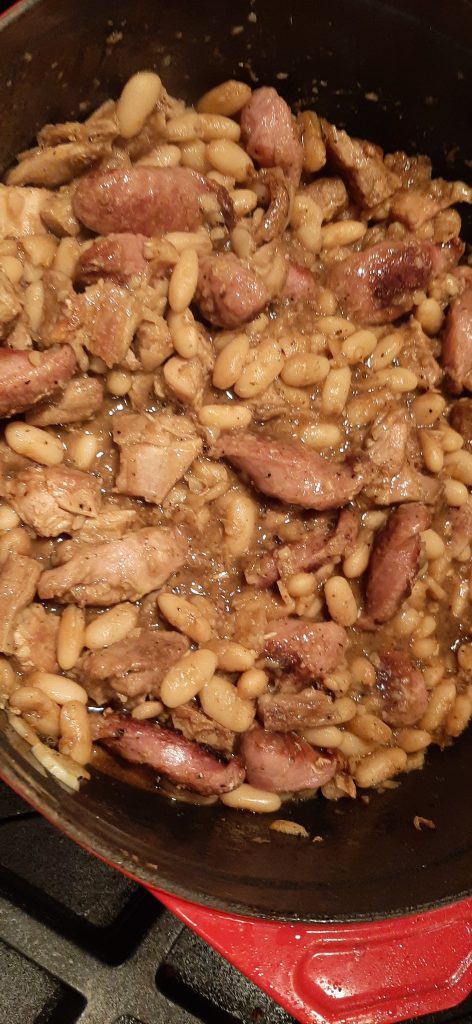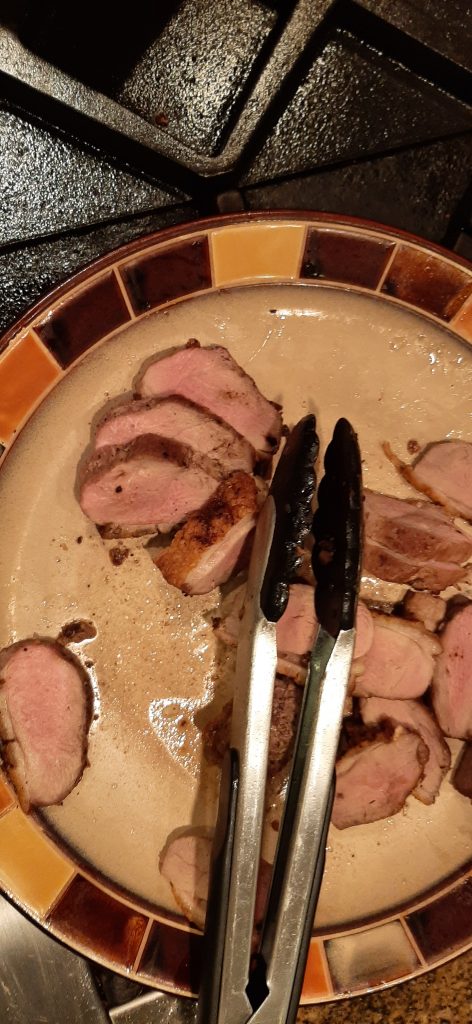
Cassoulet before topped with duck

Cooked duck for topping/garnish
As the Beatles sing “I get by with a little help from my friends”. In this case, “a lot of help from my friend”. My friend, this time, being Jim.
It all started with me buying all the meat for cassoulet about a year ago. Then of course, time went by and the ingredients for this classic French dish languished in the freezer portion of our basement refrigerator/freezer. Until one day when Mr. C. asked me for maybe the 4th time when I was going to use the expensive meat I had purchased to try my hand at making cassoulet? Well, I can take a hint! (Especially after 4 “reminders”.) Huh, perhaps I should get my act together and use the meat as planned. So, I called Jim and Margo and invited them to dinner.
My cassoulet was OK, but both Jim and I felt it needed some work. So, Jim suggested we prepare the dish together for our Christmas Eve dinner. What a grand idea! (It actually saved me coming up with a dinner plan. So, I was thrilled on two levels.)
So, the recipe you find below is the result of a joint venture. But I must confess, most of the reason the recipe turned out to be so delicious, is all on Jim. So, we all have Mr. H. to thank.
Well, that’s it for today. Last night Mr. C. had a gig which I attended. Tonight, we are driving to Seattle to hear “Nearly Dan” (a Steely Dan tribute band) at Jazz Alley. And tomorrow Mr. C. has another gig. (There truly is no rest for the wicked.) Anyway, keeping busy keeps us out of trouble. And that’s always a good thing.
And do try this cassoulet recipe. It contains far fewer ingredients than some and comes together fairly quickly. Not an inexpensive dish to make. Especially since it was originally considered peasant food. But how many people these days have ducks living in their backyard, or back bacon or duck fat, etc., just lying around? Not this couple, that’s for sure. And cannellini beans don’t grow on trees here either. So, many of the ingredients for this recipe must be purchased at a premium.
But for a special occasion, this is just the perfect comfort food to serve your family and friends. On that happy note – peace and love to all.
1 lb. dried cannellini or cassoulet beans, rinsed
chicken stock (preferably homemade – recipe below)
8 garlic cloves, sliced
1 c. diced onion
4 bay leaves
2 duck breasts patted dry with paper towels and the skin scored
6 oz. back bacon (unsmoked if possible) cut into ¾-inch cubes (sometimes referred to as “fat back”)
2-3 bone-less, skinless chicken thighs
½ lb. garlic sausage like Kielbasa or a French style, unsmoked garlic sausage, cut into 1-inch pieces on the diagonal
duck fat, if needed
kosher salt, if needed
freshly ground black pepper (quite a bit)
Day 1:
In a Dutch oven, cover beans with 1 quart chicken stock. Add the garlic, onion, and bay leaves. Cover and refrigerate overnight.
Day 2:
Remove beans from fridge. Add 2 cups of chicken stock and bring to a boil, reduce heat, and simmer until the beans are tender. (This could take a couple, three hours, so plan ahead.) Keep adding chicken stock as required.
While the beans are cooking, place the duck breasts, skin side down in a cold frying pan. Slowly fry the duck breasts over medium heat until the fat is rendered, and the skin is crispy. Flip and brown the second side. Remove from pan (keeping the pan on your stove) and place the duck breasts in an oven proof pan and bake in a pre-heated 350-degree oven only until the internal temperature reaches 125-degrees. Remove from oven and set aside. Pour any duck fat remaining in pan in with the beans. (You can even deglaze the pan with a bit of chicken stock and throw that in with the beans too. The more flavor base the better.) When cool, slice the duck breasts into thin strips.
While the duck is in the oven, cook the back bacon until crispy in the same pan you used to cook the duck. Remove from pan and set aside.
Add the chicken thighs to the same pan and cook until golden brown on both sides. Remove from pan and set aside. When cool cut into small pieces.
Next brown the sausage, adding more duck fat as needed. When browned, remove from pan. Set aside until needed.
Deglaze the pan with chicken stock and add the liquid plus brown bits to the pot of beans along with all the pieces of meat except the duck. Add stock as needed for desired consistency. Cook until the beans are tender. Taste and add salt if necessary and black pepper.
To serve, scoop the beans and meat into large flat soup bowls. Top with duck, skin side up so that it stays crispy. Serve with garlic bread or any toasted chewy bread.
Please note: This cassoulet can be served as a thick stew or as a soup. It all depends on how much stock you add to tenderize the beans. Either way, you are in for a treat.
CHICKEN OR TURKEY STOCK*
4 lbs. chicken or turkey parts, pieces, giblets, and bones
1 onion, roughly chopped
1 leek, white and green part, roughly chopped
2 carrots, cut into 1-inch sections
2 celery ribs, plus leaves, cut into 1-inch pieces
2 garlic cloves
1 bay leaf
3 T. fresh parsley
1 tsp. dried thyme
6 peppercorns
3 qt. water
Spread the chicken or turkey bones, etc. on one very large or 2 smaller rimmed baking pans. Bake in a pre-heated 400-degree oven for 1 hour or until the chicken or turkey is well browned. Remove from oven and place the meat in a large, covered Dutch oven and pan.
Pour a small amount of water in the pan(s) and let sit for several minutes. Then using a sturdy spatula, lift all the browned bits off the bottom, along with the water, and add to the pot with meat. Then add all the remaining ingredients. Bring to a boil, cover, reduce heat, and simmer for at least 3 hours.
When ready to use or store for future use, remove from heat and let cool for about 30 minutes. Then strain the liquid into a container. Discard all the meat and veggies. If you aren’t going to use the stock immediately, place covered in your refrigerator. Before using, if desired, remove the fat that has formed on the surface.
Use in any recipe calling for stock or broth**.
*Stock is a rich, savory liquid prepared by simmering bones (and in my recipe – flesh) and vegetables in water for hours with herbs and spices until the flavor is extracted. Stock derives its flavor primarily from protein, not from heavy sodium. As a result, stock is usually healthier than broth and delivers a richer mouth feel and deeper flavor than broth.
**Broth, on the other hand, usually contains flesh (no bones) plus a lot of salt. It can be used any time stock is listed as an ingredient. But be aware that it might be quite salty. So, plan to adjust your recipe accordingly if you are using broth rather than stock.
